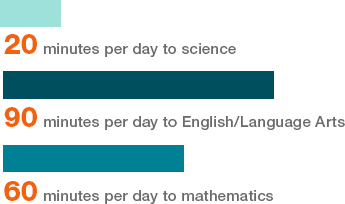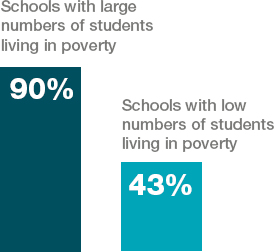How Far Are We from This Vision for All Students?
While there are many strong examples of high-quality science education across the country, science remains an afterthought in too many communities. In the United States, whether rich or poor, Black, Latino/a, Pacific Islander, Native American/Alaska Native, Asian, or White, too few are receiving the rich science instruction and experiences they need. However, within and across districts and within and across states, there exist wide disparities in access to high-quality learning experiences, well-prepared teachers, high-quality curriculum and curriculum-based professional learning, instructional materials, and assessments. Students of color and students experiencing poverty are particularly unlikely to have high-quality science learning experiences across K-16. Here we focus on illuminating the situation today and the opportunity gaps that currently exist.
K-12 Science Education
Only 22 percent of American high school graduates are proficient in science [25]. It is not hard to understand why. The average American elementary classroom devotes less than 20 minutes per day to science, but nearly 90 minutes to English/Language Arts and nearly 1 hour to mathematics [26]. This is likely in part due to the unintended consequence of state school accountability systems built as a result of No Child Left Behind (NCLB) and its successor, the Every Student Succeeds Act. The law mandates

testing in reading and mathematics in grades 3-8 and once in high school but requires an assessment in science only once in each grade-band, K-5, 6-8 and 9-12. It does not require science to be built into state accountability systems. There has been a decline in the time spent on elementary science since 2000, the year NCLB was passed [27]. There is wide variation across states in how much time for science is required in elementary school [27]. In states that include science in accountability for fourth grade, fourth-grade teachers report spending more time on science [28].

Less exposure to science in elementary school could be problematic for students who do not have access to science learning opportunities in their homes and communities [13]. For these students, limiting early science learning opportunities in school may leave them unprepared for science courses in middle and high school [29].
In addition to challenges in the time spent on science in elementary, there are challenges in providing high-quality science learning experiences across K-12. While some K-12 students today carry out investigations, analyze data, draw evidence-based conclusions, and communicate results, few students have these kinds of high-quality science learning experiences consistently across their educational journeys. Many students still experience more traditional science classes that are not grounded in the evidence about how people learn [30]. In a nationally representative survey of science teachers, less than one-half reported using the kinds of instructional practices we are calling for at least once a week; only about 25 percent reported that they place heavy emphasis on increasing students’ interest in science [26]. There is also a substantial opportunity gap; students in high poverty elementary and middle schools are less likely than students in more affluent schools to do “hands-on” work every week [30].
And for many students, instructional materials, supplies, and other critical curriculum resources are insufficient. High-quality instructional resources are starting to be more available, but many students are still provided with out-of-date textbooks and have their laboratory or investigation work limited by a lack of material and supplies [31, 26]. The lack of science facilities is also a problem [31]. Elementary and middle school students in schools that enroll high percentages of students living in
poverty have less access to space to conduct investigations and are far less likely to have ample supplies to support the investigations they do conduct than their peers in schools where students are more affluent [30]. The pandemic also revealed the sharp disparities in access to technology to support learning including lack of adequate broad band services, which is a particular problem for low-income families and in rural areas [32].
Having an underprepared, nondiverse teaching workforce is also a challenge. In a recent national survey, the majority of elementary teachers (69%) reported they are not very well prepared to teach science, and scores of secondary teachers say they are not very well prepared to teach many topics related to their disciplines [26]. This is the case even in well-resourced schools. For example, 36 percent of biology teachers in these schools report that they are not very well prepared to teach cell biology, and 39 percent ecology and ecosystems. Sixty-three percent of physics teachers report they do not feel very well prepared to teach properties of waves [26].

The problem of teachers’ lack of preparation to teach science is more acute in schools that serve higher percentages of students of color and students living in poverty. In these schools, students are more likely to be taught by inexperienced teachers and, in secondary schools, are less likely to be taught by a teacher with a relevant degree or advanced courses in the subject taught [33].
Further, far too many school districts have difficulty recruiting, hiring and retaining licensed STEM teachers [34]. Staffing shortages are more acute in schools that serve higher percentages of students living in poverty and in rural areas. Staffing patterns vary across states and are highly localized partly because teachers tend to work close to where they did their training [20] (See Box 6 for information about challenges for STEM education in rural areas.).
The science teaching corps is also not diverse. Eight of 10 public elementary, middle school, and high school science teachers are White [35], denying students of color the role models that drive greater effort in school and foster higher college goals [36]. There are particular difficulties with attracting and retaining teachers of color. Teachers of color are more likely to work in schools that are in high-poverty, urban communities and they are more likely to change schools or leave the profession than White teachers. These higher rates of turnover may be tied to poor working conditions in the schools where teachers of color are more likely to work [37].
Science students in high-poverty secondary schools, rural schools, and schools with high numbers of students of color are less likely to be enrolled in college prep courses. Data from the National Center for Education Statistics show that White students are more likely to earn their highest-level science credit in an Advanced Placement or International Baccalaureate course than Black and Latino/a students. Black and Latino/a students also amass fewer years of high school science credit on average than do White students [38].
Similarly, high-poverty schools are at least 1.5 times as likely as low-poverty schools to lack advanced coursework in mathematics and science [1]. For example, 14 percent of

schools that enroll the fewest numbers of Black, Latino/a and Indigenous students offer no biology courses, 18 percent offer no chemistry courses and 31 percent offer no physics courses. In contrast, in schools that enroll large percentages of Black, Latino/a and Indigenous students, 29 percent offer no biology courses, 42 percent offer no chemistry courses, and 59 percent offer no physics courses [39]. Similar trends in lack of access to science courses can be seen in schools enrolling significant numbers of students living at or below the poverty line [39]. For schools to offer these courses, they need to be able to hire teachers who have the science background required to teach them.
Disparities exist for rural students as well. In 2015, the percent of rural high school seniors (62%) who had access to at least one Advanced Placement STEM course was substantially lower than seniors in urban (88%) and suburban schools (93%). The percentage of rural students (48%) in that same year who scored a 3 or higher on their STEM Advanced Placement exam was also lower than urban (52%) and suburban (62%) students [40].
These patterns in access and course-taking have implications for whether students are able to smoothly transition to postsecondary education. Some state university systems have course-taking requirements for entry that are more difficult to meet in schools that do not routinely offer all the necessary courses [41].
Taken together these opportunity gaps make clear why there are performance differences in science between White students and their Black, Hispanic, and Native American and Alaska Native peers. The 2015 National Assessment of Educational Progress (NAEP) for Science (administered to fourth, eighth and twelfth graders) revealed performance gaps between White students and students form these racial groups no lower than 26 and as high as 34 points on a 300-point scale. The 2015 NAEP assessment also revealed 33- and 27-point differentials between fourth- and eighth-grade students on free and reduced lunch and those not enrolled in the program [25].
Postsecondary Education
Even students who are qualified to enter postsecondary education do not always continue on after high school graduation. There is evidence that students experiencing poverty are more likely to change their postsecondary plans. The phenomenon known as “summer melt,” in which enrolled students do not show up for the fall semester, is much more common for students experiencing poverty, those who attended large city school districts, and those originally planning to attend community college. Rates can be as high as 40 percent for these groups, compared to 10-20 percent for others [42].
There are also regional variations in access to postsecondary institutions that can shape the paths students take after high school. For a variety of reasons—jobs, family, cost, ties to the community—many students choose to pursue postsecondary education close to home. Uneven geographic distribution of colleges and universities means that in some areas of the country students do not have access to a public college option, or to a college that matches their level of academic credentials [43, 44]. This is more likely to be the case in rural or moderately sized communities leaving students in these communities with fewer options [43, 44].
Quality of science instruction is also a problem in postsecondary education. Lecturing is still prominent in undergraduate STEM courses; one study reported it was used on average 75 percent of the time and that students spent an average of 87 percent of their class time listening to instructors [45]. While White students reported the fewest negative effects resulting from poor quality STEM teaching, students of color were more likely to blame themselves for learning problems instead of the poor teaching [46]. While instructors also used some class time for group work, posing questions, and student writing, even flexible classroom layouts and small course sizes did not necessarily lead to an increase in these or other student-centered practices. This suggests that multiple changes, likely including pedagogical training, are needed to raise the quality of teaching [45].

Pathways into and through postsecondary science become complex as students take courses in more than one institution and may step in and out of enrollment [16]. The complex array of pathways that students can take to obtain science degrees is not easily navigated, and students encounter barriers of many types along the path to earning a degree [16]. The environments they encounter when they begin college may not be welcoming, in addition to the low-quality teaching described above. Barriers also result from departmental, institutional, and national policies. Students may find themselves inadequately prepared for the rigor of college coursework or they may face stereotypes from faculty or peers [16]. They also report that it can be challenging to receive academic help or advising [46]. Therefore, these barriers apply to classrooms experiences as well as impacting other aspects of campus life.
The weed-out culture in which a significant percentage of students in introductory courses are expected to fail and leave the field has a big influence on the experiences of new undergraduates interested in a STEM major [16, 47]. In fact, the majority of all students who enter 4-year institutions intending to major in the natural sciences, technology, engineering, and mathematics do not earn a degree in these fields. Many drop out of college and others switch majors, often citing the low quality of the teaching as a major reason [46, 48]. Departmental efforts to create change can be hampered by the lack of data available to inform reform decisions. Without reliable information about where students encounter barriers, the nature of the barriers, and profiles of the students who encounter barriers, it can be difficult for leaders to determine what actions to take [16].
Comparable percentages of Black, Latino/a and White college freshmen report that they intend to major in a science or engineering field [49] and declare a STEM major [47]. However, only 43 percent of Latino/a students and 34 percent of Black students persist to earn a STEM degree compared to 58 percent of White students [47]. Of total STEM degrees awarded, approximately 9 percent went to Black graduates and 9 percent to Latino/a graduates, despite Black people comprising 14 percent and Latino/a people being 18 percent of the U.S. population [38].
Students of color are more likely to attend community colleges and 2-year private institutions, which have fewer resources than 4-year colleges [16]. In 2018, 44 percent of all Latino/a and 36 percent of all Black undergraduates attended 2-year institutions; 31 percent of all White undergraduates did [50]. Yet compared to 4-year colleges, 2-year colleges have almost $9,000 less revenue per student to devote to faculty salaries and student supports [51]. Financial issues are also relevant at the level of individual students. Black students borrow more than other students for the same degrees and are less likely to complete their degrees, so can be left with debt despite lacking the credential that could drive a higher earning potential [52, 53].
Higher education faculty are less likely to be people of color than their students. Only 24 percent are not White compared to 45 percent of students [54]. The absence of diversity among faculty at the collegiate level appears to impact learning as well, some studies indicate that students perform better when their instructors are of the same race or gender [55, 56, 57, 58]. In addition, the training of higher education faculty focuses on research rather than teaching and many incentives push them to devote more energy to research than improving their pedagogical skills and teaching strategies, reinforcing the continued use of traditional approaches to teaching. [45]
Workforce and Society
There are also broader and historic systemic inequities that make it harder for some students to have the opportunity to continue in science. We have already noted the nation’s poor track record of preparing a STEM workforce that looks like the nation. Although we know that K-12 and higher education have played a role in producing disparities in STEM employment, we also acknowledge that there are historic systemic inequities outside of education that limit opportunity. Gender inequities can be traced to past and current injustices, including the absence of suffrage and legal protections, uneven access to education and employment opportunities, and belief systems that math and science are disciplines reserved for White men, for instance. The racial disparities in STEM professions—like so many other racial inequities—are created by a complex set of injustices piling up on each other over centuries, such as housing and employment discrimination and discriminatory lending practices that have denied communities of color family wealth and made it far more difficult for them to aspire to and purchase a college education [59, 60, 61].

There is already a huge income gap between White people and people of color. The U.S. Census Bureau reported on the real median household income by race and Latino/a origin in 2018 [62]. The average household income for people who are non-Latino/a White was $70,642, compared to $51,540 for people who are Latino/a of any race and $41,361 for Black people. There is
also a profound gap in family wealth, particularly between White people and Black people. The Brookings Institution reports that in 2016 the net worth of the typical White family was $171,000, a figure almost 10 times higher than that of the typical Black family, with wealth of only $17,150 [63].
More, these acts of discrimination have created racially isolated communities of color, particularly in neighborhoods that are underresourced and serviced by schools that are also racially isolated and often do not offer the same educational opportunities that White students have in metropolitan communities. In fact, 70 years after Brown v. Board of Education, students of color are more likely to attend racially segregated schools. Sixty percent of Latino/a, 58 percent of Black, 53 percent of Pacific Islander, and 37% of American Indian students are enrolled in them compared to 5 percent of White students [38]. If these racially isolated communities have high levels of families experiencing poverty—and racial residential segregation and racially concentrated poverty go hand-in-hand [1, 64]—then opportunities to experience high-quality science learning are far more limited. For example, schools with the greatest percentage of students experiencing poverty are less likely to offer any physics course (90% v. 43%) than schools with the lowest percentage [30].

On top of these systemic racial and socioeconomic inequities, people of color must confront individual and institutional biases. These biases include assumptions that they are less capable, cannot succeed in school, and are destined for low-wage professions. Biased stereotypical views about the interest or abilities of particular students or demographic groups work in both subtle and overt ways to curtail their educational experiences and result in inequitable learning supports [14]. They also impact outcomes. Recent research suggests that educators have a “slight” implicit anti-Black and pro-White bias, and in counties in which these biases are stronger, there are greater racial disparities in test scores and suspensions [65]. These factors combine to result in students of color having different learning experiences and opportunities compared to their White classmates and that in turn means that their ability to continue in science is limited in ways that contribute to current patterns of employment [6].









